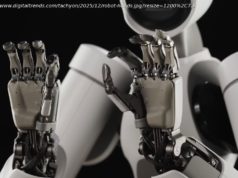By Ralph Haupter, President, Microsoft Asia. This article was originally posted on LinkedIn. Ever heard the old Beatles song ”Here, There and Everywhere” from the 1960s? Okay, that was a long time ago now – certainly before PCs, tablets, smartphones,…
By Ralph Haupter, President, Microsoft Asia. This article was originally posted on LinkedIn.
Ever heard the old Beatles song ”Here, There and Everywhere” from the 1960s? Okay, that was a long time ago now – certainly before PCs, tablets, smartphones, social media and the internet came along.
Even so, it could be an anthem for the future as its title neatly sums up how our digital and physical worlds will change, thanks to the next big shift in technology: Artificial Intelligence (AI) .
And it promises to be good news for all of us here in Asia Pacific.
Let’s look at the big picture. Today’s mobile-first, cloud-first world is evolving into a new world order, dominated by the intelligent cloud and the intelligent edge.
Right now, flows of data being created and collected by devices at the “edge” of the network are typically funneled into a centralised cloud. But we see a different way ahead, one that is closer to the user.
Here, applications will operate across multiple integrated devices that will be able to process ever-increasing amounts of their own data. With more data being collected and used on devices, more computing power will also move over to the “edge”. And, that opens the way for devices to take on machine learning, which is needed to build AI.
The intelligent edge is the interface between the computer and the real world, and creating it is a step towards realising the promise of a world of devices, products and machines infused with AI.
In this new world, we will be able to search our surroundings just like we now search the web. And in time, devices of all sorts will be able to grasp context, recognise images, acquire knowledge, comprehend speech and understand us.
AI will, quite literally, be here, there and everywhere: in what we do, what we make, how we work, how we learn, travel or play – more or less how we live.
Our region’s massive populations, fast-growing economies, and rising living standards are well positioned to ride the AI wave. And, it is exciting to know that the Asia Pacific’s next generation, which represents about 60 percent of the world’s youth, already seems to understand this.
A few months ago, Microsoft Asia surveyed 1,400 young people in Australia, China, Hong Kong, India, Indonesia, Japan, South Korea, Malaysia, New Zealand, Philippines, Singapore, Taiwan, Thailand and Vietnam to better understand the role of technology in their future lives. And the #1 technological innovation that these young citizens felt was most likely to have the greatest impact on their lives was AI.
For them, a future infused with AI would be bright. Thirty-nine percent envisaged using connected or driverless cars. Another 36% thought future software robots would improve productivity, and 19% thought robots could become their social companions.
Most also believed AI and other new technologies would help them become more productive, to better connect with others, and improve their physical and mental health.
The region’s enthusiasm for AI doesn’ t stop there. Technologists working in Asia Pacific are among those at the forefront of its development. At Microsoft’s Research Lab in China, more than 200 researchers are doing cutting-edge work, infusing AI elements into many products that consumers use today, such as Windows, Office, Bing, and Xbox.
One of their standout achievements has been Skype Translator, which allows you to chat with your contacts in different languages, including Mandarin, in real-time.
Imagine doing the same, but for an entire audience with a choice of more than 60 languages. That’s what Microsoft’s new PowerPoint Presentation Translator add-on does. As you present your deck, it translates your voice in real-time into a different language as subtitles at the bottom of your slides.
Additionally, it provides translation into other languages on the devices of individual audience members. They can also then ask questions in their own language, which, in turn, are translated back. While it’s still in its early stages, the feature powerfully demonstrates the capabilities of Microsoft ‘s Cognitive Services tools. Think of how this can be applied – from international trade, to global business, to diplomacy, to education. The list goes on.
Meanwhile, Microsoft researchers in Hyderabad, India are starting to consider how machine learning and real-time big data analytics might be used to teach virtual assistants, like Cortana, how to understand multilingual conversations – such as when a human switches from one language to another, say from Hindi to English.
In another part of India, farmers who are worried about unreliable monsoons are also looking to AI. In the state of Andhra Pradesh, village farmers need to plant their crops just ahead of seasonal rains. Getting the timing right can be the difference between a good harvest and a failed crop. But the effects of climate change are making rain patterns less predictable.
In response, Microsoft and the agricultural research group, ICRISAT, have built an application that brings scientific certainty to this problem. Using Cortana Intelligence Suite, Machine Learning, Data Analytics and Power BI, the app collects and analyses weather and soil data to let farmers know via phone text messages when it is best to plant.
A pilot project last year resulted in an impressive 30 percent jump in yield. Almost two-thirds of India’s arable land is rain-dependent, so this sort of solution has the potential to change the lives of vast numbers of farming families.
AI can also be used to make Asia’s busy factories and construction sites safer. With existing camera technology and advances in the Intelligent Edge, Microsoft is helping to pioneer an AI system that can monitor a factory floor and watch for anomalies that – otherwise unnoticed – could lead to an accident.
Let’s say if a canister of dangerous chemicals falls off a shelf, the ever-alert system would immediately notify safety crews of a spill and warn workers to stay away from the hazard.






